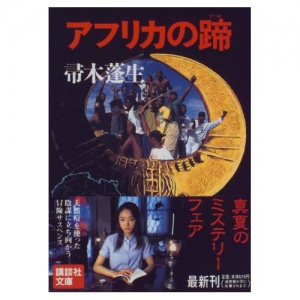8回目の授業、後半に入りました。今日中に授業のページを書いとかんとね。
<今回>は
Mass MOBILIZATION AND OPPRESSIONとTHE ARMED STRUGGLEを阿久根さんがやってくれました。日本語訳もきちんとやれてたと思います。日本語訳は最後に貼っときますので、細かいところは見比べてや。
前からみてきたように、支配階級(3%ほど)は自分の富を増やしたり守ったりするのに何でもしてきた、南アフリカの場合、人種差別も利用してきた、その実態は、可能な限り搾取出来るように最低賃金を抑えるという制度を作り、大多数のアフリカ人の賃金を据え置き、アフリカーナーのプアホワイトを優遇して、その間にカラーラインをひいた、それが南アフリカの場合はapartheidアパルトヘイト。
そのアパルトヘイトに立ち向かったソブクエの話と学生運動で他の人の起点になった山本義隆さんの話もしました。ソブクウェについては日本ではほとんど誰も紹介していないのであまり知られてないけど、歴史の分岐点の鍵を握る人物やったと思います。白人政権は先進国特にアメリカ、イギリス、フランス、西ドイツ、日本と手を携えて体制を守りました。ソブクウェはマンデラよりも早くロベン島に拘禁され、54歳で肺がんで死ぬまで自宅拘禁を強いられました。白人政府は一番体制に脅威を与える人物を完全に閉じ込めるのに成功したわけです。詳しくは↓に書いています。ソブクウェの良き理解者であったベンジャミン・ポグルンドもロンドンに亡命したあとソブクウェの伝記を出しました。この二十年の間に、感動を覚えながら読んだ数少ない本で、是非ともソブクウェについて書きたいと思いました。
1960年3月21日、仲間と警察署に向かうソウブクエ
(ベンジャミン・ポグルンドの伝記から)
→「ロバート・ソブクウェというひと ① 南アフリカに生まれて」(「ゴンドワナ」20号14-20ペイジ、1993年)
→「ロバート・ソブクウェというひと ② アフリカの土に消えて」(「ゴンドワナ」21号6-19ペイジ、1994年)
<次回>は
リザーブ(バンツースタン、ホームランド)→(安価な労働力の例として)ダーバン郊外の砂糖黍畑で働く12歳のアフリカ人少年(農場で)→ヨハネスブルグの金鉱山(1972年頃と1987年ころ)→労働組合委員長のインタビュー→たこ部屋(Compounds, Hostels)から鉱山近くの粗末な売店に行く茂みで待ち受ける売春婦の映像を観てもらい、「グレースランド」のスティメラを観て、聴いてもらいたいと思っています。
時間があれば1992年に行ったジンバブエのハラレの話も。いいカメラで撮って来た写真もようさん見てもらえたら。
先にコメント、トーイックのサンプル問題も少しは出来るとええんやけど。
また、来週に。
*******
MASS MOBILIZATION AND OPPRESSION 大衆動員と抑圧
Despite severe oppression the ANC continued to work openly. But it soon abandoned its former policy of deputations and petitions, and launched a new phase of mass actions. The adoption of the Programme of Action in 1949 signalled this new stage in the struggle, and the next years showed a capacity for militancy among the black population.
厳しい抑圧にもかかわらず、アフリカ民族会議は公然と活動を続けました。しかし、アフリカ民族会議すぐにそれまでのように代表者を派遣したり懇願するのはやめて、大衆行動という新しい段階に突入しました。1949年の行動綱領の採択は解放闘争の新しい段階の前触れで、その後の何年かで、アフリカ人が積極的に闘う能力があることが証明されました。
In 1953 the ANC started to prepare a large national conference with representatives from all racial groups and from various organizations. In contrast to the all-whie parliament in Cape Town this conference was to express the will of the whole South African people. A large number of meetings were held in towns, factories, and on farms to formulate proposals for delegates and for the conference declarations. On 25 and 26 June 1955 more than 2,850 delegates from all over South Africa gathered in Kliptown outside Johannesburg and, after discussions, adopted the Freedom Charter.
1953年に、アフリカ民族会議はすべての人種グループと色々な組織の代表者による大規模な国民会議の準備を始めました。ケープタウンでの白人だけによる議会とは対照的に、この議会は、すべての南アフリカの人々の意思を表わしたものでした。たくさんの会議が町や工場や農場で行なわれ、代表と会議の宣言のための草案が作られました。1955年6月25日と26日に、南アフリカじゅうの2850人以上の代表者がジョハネスバーグ郊外のクリップタウンに集まり、議論の末に、自由の憲章が採択されました。
This document opens with the words, 'We, the people of South Africa, declare for all our country and the world to know: that South Africa belongs to all who live in it, black and white, and that no government can justly claim authority unless it is based on the will of the people . . .’ It also says that land shall ` be shared among those who work it, that the doors of learning and culture shall be open to all, and that the mineral wealth, the banks and monopoly industry shall be transferred to the people as a whole. The organizations which had arranged the Kliptown conference joined to form the Congress Alliance. It consisted of the ANC, the South African Indian Congress, the South African Coloured People’s Congress, the Congress of Democrarts (a white organization), and the trade union central body SACTU (the South African Congress of Trade Unions). The SACP worked under- ground ever since it was banned in the early 1950s.
この憲章は以下の言葉で始まります。「私たち南アフリカ人民は、すべての国と世界に知ってもらえるように宣言します。南アフリカは黒人も白人も、そこに住む人々に属し、人々の意志に基づかないない限り、どんな政府も公正に権利を主張できない、と・・・。」また、土地はそこで働いている人たちの間で分配され、学問や文化の門戸はすべての人に開かれ、豊かな鉱産資源や銀行や独占企業はひとまとめで人々の手に引き渡すと宣言しました。クリップタウン会議に参加した組織は会議運動を形成しました。それはANC、南アフリカインド人会議、南アフリカカラード人民機構、民主主義者会議(白人の組織)、そして労働組合の本体SACTU(南アフリカ労働組合会議)で構成されていました。SACP(南アフリカ共産党)は1950年代初期に活動禁止処分を受けて以来、地下活動を行ないました。
REFERENCE4 参照4
Benjamin Pogrund, a South African journalist, introduced the PAC major aims listed by Sobukwe and five aims adopted by the Congress in his book Sobukwe and Apartheid:
南アフリカの新聞記者ベンジャミン・ポグルンドは、ソブクウェが挙げたPACの主な目的と、国民会議で採択された5つの目標を著書『ソブクウェとアパルトヘイト』の中で紹介しています。
“Sobukwe listed three major aims: firstly, politically, `the government of the Africans, by the Africans, for the Africans, with everybody who owes his only loyalty to Africa and who is prepared to accept the democratic rule of an African majority being regarded as an African. We guarantee no minority rights because we think in terms of individuals not groups.’ Secondly, `economically we aim at the rapid extension of industrial development in order to alleviate pressure on the land which is what progress means in terms of modern society. We stand committed to a policy guaranteeing the most equitable distribution of wealth.’ Thirdly, `socially we aim at the full development of the human personality and the ruthless outlawing of all forms of manifestations of the racial myth.’ "
「ソブクウェは主な三つの目標をあげました。第一に、政治的にはアフリカに忠誠心を置き、誰もがアフリカ人として大多数のアフリカ人の民主主義的な支配を快く受け入れる、アフリカのための、アフリカ人による、アフリカ人の政府。集団として見なすのではなく、個人として考えるので、少数派の権利は保証しません。」第二に、「経済的には、土地への抑圧を減らすために、産業の発展を急速に拡大させるつもりです。現代社会ではそれが進歩を意味しますので。富の最も公平な分配を保証する政策も推進する方針です。」第三に、「社会的には、各個人の人間性の十分な発達と、あらゆる種類の明らかな人種差別を法律的に徹底的に排除したいと考えます。」
“Five aims were adopted: `(a) to unite and rally the African people into one national front on the basis of African Nationalism; (b) to fight for the overthrow of white domination, and for the implementation and maintenance of the right of selfdetermination for the African people; (c) to work and strive for the establishment and maintenance of an Africanist Socialist democracy recognising the primacy of the material and spiritual interests of the human personality; (d) to promote the educational, cultural and economic advancement of the African people; (e) to propagate and promote the concept of the Federation of Southern Africa, and Pan Africanism by promoting unity among peoples of Africa.’ "
「五つの目標が採択されました。「(a) アフリカナショナリズムを基に、アフリカ人民をある国民前線に団結させ、集めること。(b) 白人支配打倒と、アフリカ人の自己決定権の実現と維持のために闘うこと。(c) それぞれの物質的、精神的利益が最も大切あると認め、アフリカの社会民主主義の確立と維持のために働き、闘うこと。(d) アフリカ人の教育、文化、経済の向上を奨進すること。(e) アフリカの民族間の統合を推進して、南部アフリカ連合とパンアフリカニズムの概念を普及し、奨励すること。」
In 1959 the ANC decided to organize a mass protest against the pass laws. The protest was going to begin on 31 March 1960. In the same year the PAC drew up a plan to campaign for freedom for South Africa by 1963. The PAC campaign began on 21 March 1960. On the day thousands of people gathered at the police station in Sharpeville Township. The police opened fire, and 69 people were shot dead. This became known as the `Sharpeville massacre.’ On the day, Sobukwe and other leaders were arrested.
1959年に、ANCはパス法に反対して大規模な抗議運動を計画することを決めました。抗議運動は1960年の3月31日に始まる予定でした。同じ年に、PACは1963年までに南アフリカの独立を求める運動を展開する計画を立てました。PACの抗議運動は、1960年の3月21日に始まりました。その日、数千人の人がシャープヴィルの警察署に集まりました。警察は発砲し、69人を射殺しました。これは「シャーペビルの大虐殺」として知られるようになりました。その日に、ソブクウェと他の指導者たちは逮捕されました。
THE ARMED STRUGGLE 武力闘争
The Sharpeville massacre became the turning point. The ANC and the PAC were banned and forced to start an armed struggle. In 1961 the ANC formed an army called `Umkhonto we Sizwe’ (`the Spear of the Nation’) and the PAC formed a secret army called `Po(g)qo’ (`Alone’). The Umkhonto began to blow up pass offices and electricity power-lines, while the Poqo began to attack chiefs and policemen. But in 1963 the police arrested their leaders. By 1964 all of them, including Nelson Mandela, were imprisoned. A period of decline followed. Many leading activists had to flee the country to escape arrest. The work underground proceeded but with great difficulties. Open actions could not be carried out. By 1965 the armed struggle had been crushed. The PAC and the ANC were forced to continue their armed struggle from outside South Africa. The parties’ leadership and liberation armies moved to Zambia and Tanzania and their military training took place in Africa and overseas. They sometimes linked up with the liberation armies in Southern Rhodesia (Zimbabwe).
シャープビルの大虐殺は転機点になりました。ANCとPACは非合法化され、武力闘争を開始せざるを得ませんでした。1961年にANCは「ウンコントウェシズウェ」(民族の槍)と呼ばれる武力闘争部門を創設し、PACは「ポコ」(単独で)と呼ばれる秘密の武力組織を作りました。ウムコントはパス(通行証)管理局や送電線を破壊し、ポコは首長(チーフ)や警察官の襲撃を始めました。しかし1963年に、警察は両組織の指導者を逮捕しました。1964年までに、ネルソン・マンデラを含むすべての指導者が投獄されました。衰退の時期が続きました。多くの指導的立場にいた活動家が、逮捕を逃れれて国外に逃亡しました。地下活動は続きますが、非常に困難を極めました。公の活動は実行出来ませんでした。1965年までに、武力闘争は抑えこまれました。PACとANCは南アフリカの外から武力闘争を続けざるを得ませんでした。党の指揮権や解放軍はザンビアやタンザニアに移り、軍隊訓練はアフリカや海外で行なわれました。両者は時々、南ローデシアの解放軍と連携しました。






